Sustainable Local Development: An Overview of the State of Knowledge
Abstract
1. Introduction
2. Literature Review
3. Methodology
4. Discussion and Results
4.1. General Overview
4.2. Distribution by Research Area
4.3. Most Influential Institutions
4.4. Most Influential Journals
4.5. Most Relevant Authors and Cited References
4.6. Most Influential Countries
4.7. New Trends
5. Conclusions
Author Contributions
Funding
Conflicts of Interest
References
- Amin, A. An institutionalist perspective on regional economic development. Int. J. Urban Reg. Res. 1999, 23, 365–378. [Google Scholar] [CrossRef]
- Mebratu, D. Sustainability and sustainable development: Historical and conceptual review. Environ. Impact Asses. 1998, 18, 493–520. [Google Scholar] [CrossRef]
- United Nations. Sustainable Development Goals Report; United Nations: New York, NY, USA, 2016. [Google Scholar]
- Dawkins, C.J. Regional development theory: Conceptual foundations, classic works, and recent developments. J. Plan. Lit. 2003, 18, 131–172. [Google Scholar] [CrossRef]
- Coffey, W.J.; Polese, M. The concept of local development: A stages model of endogenous regional growth. Pap. Reg. Sci. 1984, 55, 1–12. [Google Scholar] [CrossRef]
- Handayani, W. Rural-urban transition in Central Java: Population and economic structural changes based on cluster analysis. Land 2013, 2, 419–436. [Google Scholar] [CrossRef]
- Späth, P.; Rohracher, H. ‘Energy regions’: The transformative power of regional discourses on socio-technical futures. Res. Policy 2010, 39, 449–458. [Google Scholar] [CrossRef]
- Giovannoni, E.; Fabietti, G. What is sustainability? A review of the concept and its applications. In Integrated Reporting; Busco, C., Frigo, M.L., Riccaboni, A., Quattrone, P., Eds.; Springer: Cham, Switzerland, 2013; pp. 21–40. [Google Scholar]
- Hassan, S.U.; Haddawy, P.; Zhu, J. A bibliometric study of the world’s research activity in sustainable development and its sub-areas using scientific literature. Scientometrics 2014, 99, 549–579. [Google Scholar] [CrossRef]
- Ioppolo, G.; Cucurachi, S.; Salomone, R.; Saija, G.; Shi, L. Sustainable local development and environmental governance: A strategic planning experience. Sustainability 2016, 8, 180. [Google Scholar] [CrossRef]
- Nevado-Peña, D.; López-Ruiz, V.R.; Alfaro-Navarro, J.L. The effects of environmental and social dimensions of sustainability in response to the economic crisis of European cities. Sustainability 2015, 7, 8255–8269. [Google Scholar] [CrossRef]
- Zarnowitz, V. Business Cycles Observed and Assessed: Why and How They Matter; NBER Working Paper N6230; National Bureau of Economic Research Inc.: Cambridge, MA, USA, 1997. [Google Scholar]
- Van-Depoele, L.; Ebru, E. Local development strategies in the EU. The case of LEADER in rural development. In Proceedings of the National Seminar on Functioning of Local Self-Government Institutions in Punjab and EU Countries, Chandigarh, India, 16–17 August 2006; p. 21. [Google Scholar]
- European Commission. The Future of Rural Society; Office for Official Publications of the European Communities: Luxembourg, 1988. [Google Scholar]
- European Commission. Industrial relations in Europe; Office for Official Publications of the European Communities: Luxembourg, 2008. [Google Scholar]
- Wilson, G. Multifunctional ‘quality’ and rural community resilience. Trans. Inst. Br. Geogr. 2010, 35, 364–381. [Google Scholar] [CrossRef]
- Martin, R.; Sunley, P. Slow Convergence? The new endogenous growth theory and regional development. Econ. Geogr. 1998, 74, 2011–2227. [Google Scholar] [CrossRef]
- Gao, Y. Top-down and bottom-up processes for rural development and the role of architects in Yunnan, China. Buildings 2016, 6, 47. [Google Scholar] [CrossRef]
- Capello, R. Location, regional growth and local development theories. Aestimum 2011, 58, 1–25. [Google Scholar] [CrossRef]
- Porter, M.E. Location, Competition, and Economic Development: Local Clusters in a Global Economy. Econ. Dev. Q. 2000, 14, 15–34. [Google Scholar] [CrossRef]
- Elliott, J.A. An Introduction to Sustainable Development; Routledge: London, UK, 2012. [Google Scholar]
- Gómez-Baggethun, E.; Naredo, J.M. In search of lost time: The rise and fall of limits to growth in international sustainability policy. Sustain. Sci. 2015, 10, 385–395. [Google Scholar] [CrossRef]
- Beynaghi, A.; Trencher, G.; Moztarzadeh, F.; Mozafari, M.; Maknoon, R.; Leal, W. Future sustainability scenarios for universities: Moving beyond the United Nations Decade of Education for Sustainable Development. J. Clean. Prod. 2016, 112, 3464–3478. [Google Scholar] [CrossRef]
- United Nations. Report of the United Nations Conference on the Human Environment; United Nations Publications: Stockholm, Sweden, 1972. [Google Scholar]
- Tryzna, T.C. A Sustainable World: Defining and Measuring Sustainable Development; World Conservation Union: Gland, Switzerland, 1995. [Google Scholar]
- International Union for Conservation of Nature and Natural Resources. Conservation Strategy. Living Resource Conservation for Sustainable Development; International Union for Conservation of Nature and Natural Resources: Gland, Switzerland, 1980. [Google Scholar]
- McChesney, I. The Brundtland Report and Sustainable Development in New Zealand; Lincoln University and University of Canterbury, Centre for Resource Management: Christchurch, UK, 1991. [Google Scholar]
- World Commission on Environment and Development. Report of the World Commission on Environment and Development: Our Common Future; Published as Annex to General Assembly document A/42/427; Oxford University Press: Oxford, UK, 1987. [Google Scholar]
- Masika, R.; Joekes, S. Environmentally Sustainable Development and Poverty; Institute of Development Studies: Brighton, UK, 1997; Volume 52. [Google Scholar]
- Huesemann, M.H. The limits of technological solutions to sustainable development. Clean Technol. Environ. 2003, 5, 21–34. [Google Scholar] [CrossRef]
- Vanags, J.; Geipele, I.; Mote, G.; Jirgena, H. Sustainable development: Social dimension and limitation of material needs request. In Proceedings of the International Scientific Conference Business and Management, Vilnius, Lithuania, 10–11 May 2012; Vilnius Gediminas Technical University: Vilnius, Lithuania, 2012. [Google Scholar]
- Conway, G. The properties of agroecosystems. Agric. Syst. 1985, 20, 31–55. [Google Scholar] [CrossRef]
- Downs, A. Smart Growth: Why we discuss it more than we do it. J. Am. Plann. Assoc. 2005, 71, 367–378. [Google Scholar] [CrossRef]
- Naldi, L.; Nilsson, P.; Westlund, H.; Wixe, S. What is smart rural development? J. Rural Stud. 2015, 40, 90–101. [Google Scholar] [CrossRef]
- Vaz, T.D.N.; Nijkamp, P. Knowledge and innovation: The strings between global and local dimensions of sustainable growth. Entrep. Region. Dev. 2009, 21, 441–455. [Google Scholar] [CrossRef]
- Schwerdtner, W.; Siebert, R.; Busse, M.; Freisinger, U.B. Regional open innovation road mapping: A new framework for innovation-based regional development. Sustainability 2015, 7, 2301–2321. [Google Scholar] [CrossRef]
- Swagemakers, P.; Dominguez Garcia, M.; Wiskerke, J. Socially-Inclusive Development and Value Creation: How a Composting Project in Galicia (Spain) ‘Hit the Rocks’. Sustainability 2018, 10, 2040. [Google Scholar] [CrossRef]
- Butler, J.R.A.; Suadnya, W.; Yanuartati, Y.; Meharg, S.; Wise, R.M.; Sutaryono, Y.; Duggan, K. Priming adaptation pathways through adaptive co-management: Design and evaluation for developing countries. Clim. Risk. Manag. 2016, 12, 1–16. [Google Scholar] [CrossRef]
- Rinaldi, C.; Cavicchi, A. Universities’ emerging roles to co-create sustainable innovation paths: Some evidences from the Marche Region. Aestimum 2016, 69, 211–224. [Google Scholar] [CrossRef]
- Fabregà, M.B. How Entrepreneurship in Higher Education Helps to Sustainable Development at the Local Level: The Case of Tecnocampus. In Towards Green Campus Operations; Springer: Cham, Switzerland, 2018; pp. 587–604. [Google Scholar]
- Brem, A. Linking innovation and entrepreneurship–literature overview and introduction of a process-oriented framework. Int. J. Entrep. Innov. Manag. 2011, 14, 6–35. [Google Scholar] [CrossRef]
- Hadad, S. Analytic hierarchy process analysis for choosing a corporate social entrepreneurship strategy. Manag. Mark. 2015, 10, 185–207. [Google Scholar] [CrossRef]
- Istudor, L.G. Innovation and entrepreneurship in Romania’s cultural and creative industries. Int. Conf. Bus. Excell. 2018, 12, 498–507. [Google Scholar] [CrossRef]
- Katonáné, K.J.; Varga, E.; Nemes, G. Understanding the process of social innovation in rural regions. Stud. Agric. Econ. 2016, 118, 22–29. [Google Scholar] [CrossRef]
- Healey, P. Civil society enterprise and local development. Plan. Theory Pract. 2015, 16, 11–27. [Google Scholar] [CrossRef]
- Grinberga-Zalite, G.; Oganisjana, K.; Surikova, S. The Study of Social Innovation Theoretical Framework for Enhancing of Rural Development and Agriculture in Latvia. In Proceedings of the International Scientific Conference, Jelgava, Latvia, 23–24 April 2015. [Google Scholar]
- Haas, R.; Meixner, O.; Petz, M. Enabling community-powered co-innovation by connecting rural stakeholders with global knowledge brokers: A case study from Nepal. Br. Food J. 2016, 118, 1350–1369. [Google Scholar] [CrossRef]
- Lowitt, K.; Hickey, G.M.; Saint Ville, A.; Raeburn, K.; Thompson-Colón, T.; Laszlo, S.; Phillip, L.E. Factors affecting the innovation potential of smallholder farmers in the Caribbean Community. Reg. Environ. Chang. 2015, 15, 1367–1377. [Google Scholar] [CrossRef]
- Marsden, T.; Smith, E. Ecological entrepreneurship: Sustainable development in local communities through quality food production and local branding. Geoforum 2005, 36, 440–451. [Google Scholar] [CrossRef]
- Baird, T.; Hall, C.M.; Castka, P. New Zealand Winegrowers Attitudes and Behaviours towards Wine Tourism and Sustainable Winegrowing. Sustainability 2018, 10, 797. [Google Scholar] [CrossRef]
- Andrade, M.; Caamaño-Franco, I. Theorical and methodological model for the study of Social perception of the impact of industrial tourism on Local Development. Soc. Sci. 2018, 7, 217. [Google Scholar] [CrossRef]
- Castellani, V.; Sala, S. Sustainable performance index for tourism policy development. Tourism. Manag. 2010, 31, 871–880. [Google Scholar] [CrossRef]
- Bordeianu, O.M.; Chaşovschi, C.E.; Moroşan-Dănilă, L. Tourism–In Support of Rural Development. A Case Study On Training Need Analysis in Rural Area (Butea, Iași). Ecoforum J. 2012, 1, 32–41. [Google Scholar]
- Hassannia, R.; Vatankhah Barenji, A.; Li, Z.; Alipour, H. Web-Based Recommendation System for Smart Tourism: Multiagent Technology. Sustainability 2019, 11, 323. [Google Scholar] [CrossRef]
- Quaranta, G.; Citro, E.; Salvia, R. Economic and social sustainable synergies to promote innovations in rural tourism and local development. Sustainability 2016, 8, 668. [Google Scholar] [CrossRef]
- De Marco, O.; Pérez, D.; Soler, M. Indicators for the analysis of peasant women’s equity and empowerment situations in a sustainability framework: A case study of cacao production in Ecuador. Sustainability 2016, 8, 1231. [Google Scholar] [CrossRef]
- Sanogo, D.; N’Diaye, M.; Badji, M.; Beye, S.A. Optimizing the use of common resources in the groundnut basin of Senegal: An ex-ante evaluation of plans and alternatives for sustainable management. Biotechnol. Agron. Soc. 2014, 18, 339–352. [Google Scholar]
- Grönlund, Å.; Horan, T.A. Introducing e-gov: History, definitions, and issues. Commun. Assoc. Inf. Syst. 2005, 15, 713–729. [Google Scholar] [CrossRef]
- Araya, R.; Porrúa, M. América Latina Puntogob. Casos y tendencias en gobierno electrónico; Facultad Latinoamericana de Ciencias Sociales: Santiago de Chile, Chile, 2004. [Google Scholar]
- Kumar, R.; Best, M.L. Impact and sustainability of e-government services in developing countries: Lessons learned from Tamil Nadu, India. Inf. Soc. 2006, 22, 1–12. [Google Scholar] [CrossRef]
- Stein, A. Participation and sustainability in social projects: The experience of the Local Development Programme (PRODEL) in Nicaragua. Environ. Urban. 2001, 13, 11–35. [Google Scholar] [CrossRef]
- Cuthill, M. Exploratory research: Citizen participation, local government and sustainable development in Australia. J. Sustain. Dev. 2002, 10, 79–89. [Google Scholar] [CrossRef]
- Cross, C. Community policing and the politics of local development in Tanzania. J. Mod. Afr. Stud. 2014, 52, 517–540. [Google Scholar] [CrossRef]
- Llamas-Sánchez, R.; Muñoz-Fernández, Á.; Maraver-Tarifa, G.; Senés-García, B. El papel de las ciudades en el desarrollo sostenible: El caso del programa ciudad 21 en Andalucía (España). EURE (Santiago) 2010, 36, 63–88. [Google Scholar] [CrossRef]
- Martínez-Osorio, P.A.; Barana, M.; Rocha-Carneiro, R.; Paschoarelli, L.C. Innovación, design y sostenibilidad social: Nuevas tendencias para el desarrollo local en la ciudad contemporánea. Revista Arquitectura 2017, 19, 68–77. [Google Scholar] [CrossRef]
- Cabannes, Y. Participatory budgeting: A significant contribution to participatory democracy. Environ. Urban. 2004, 16, 27–46. [Google Scholar] [CrossRef]
- Dutta, A.; Banerjee, S. Does microfinance impede sustainable entrepreneurial initiatives among women borrowers? Evidence from rural Bangladesh. J. Rural Stud. 2018, 60, 70–81. [Google Scholar] [CrossRef]
- Esteban, M.L.; Pérez, F.J.; Gargallo, A. Áreas rurales y cooperativas: Iniciativas de mujeres para el desarrollo. REVESCO Revista Estudios Cooperativos 2018, 127, 116–138. [Google Scholar] [CrossRef]
- Bebbington, A. Capitals and capabilities: A framework for analyzing peasant viability, rural livelihoods and poverty. World Dev. 1999, 27, 2021–2044. [Google Scholar] [CrossRef]
- Osareh, F. Bibliometrics, citation analysis and co-citation analysis: A review of literature I. Libri 1996, 46, 149–158. [Google Scholar] [CrossRef]
- Van Raan, A.F. Advances in bibliometric analysis: Research performance assessment and science mapping. In Bibliometrics. Use and Abuse in the Review of Research Performance; Blockmans, W., Engwall, L., Weaire, D., Eds.; Portland Press: London, UK, 2014; pp. 17–28. [Google Scholar]
- Brereton, P.; Kitchenham, B.A.; Budgen, D.; Turner, M.; Khalil, M. Lessons from applying the systematic literature review process within the software engineering domain. J. Syst. Softw. 2007, 80, 571–583. [Google Scholar] [CrossRef]
- Neto, A.; Silva, S.T. Growth and Unemployment: A bibliometric analysis on mechanisms and methods. FEP Work Pap. 2013, 498, 1–29. Available online: http://wps.fep.up.pt/wps/wp498.pdf (accessed on 1 February 2019).
- Bornmann, L.; Wagner, C.; Leydesdorff, L. BRICS countries and scientific excellence: A bibliometric analysis of most frequently cited papers. J. Am. Soc. Inf. Sci. Technol. 2015, 66, 1507–1513. [Google Scholar] [CrossRef]
- Ruiz-Real, J.L.; Uribe-Toril, J.; De Pablo, J.; Gázquez-Abad, J.C. Worldwide Research on Circular Economy and Environment: A Bibliometric Analysis. Int. J. Environ. Res. Public Health 2018, 15, 2699. [Google Scholar] [CrossRef]
- Xu, L.; Marinova, D. Resilience thinking: A bibliometric analysis of socio-ecological research. Scientometrics 2013, 96, 911–927. [Google Scholar] [CrossRef]
- Mazzoni, L. In search of Creative Entrepreneurship: A bibliometric analysis of the period 1998-2016. In Proceedings of the International Conference on Regional Science, Sevilla, Spain, 15–17 November 2017. [Google Scholar]
- Hirsch, J.E. An index to quantify an individual’s scientific research output. Proc. Natl. Acad. Sci. USA 2005, 102, 16569–16572. [Google Scholar] [CrossRef]
- Jerve, A.M.; Jansen, E.G. From Research to Implementation: The Country Boats of Bangladesh and Strategies for Development Assistance to an Indigenous Transport Sector (Norwegian Aid); Chr. Michelsens Institute Working Paper A322; Chr. Michelsens Institute: Bergen, Norway, 1984. [Google Scholar]
- Allison, E.H.; Ellis, F. The livelihoods approach and management of small-scale fisheries. Mar. Policy 2001, 25, 377–388. [Google Scholar] [CrossRef]
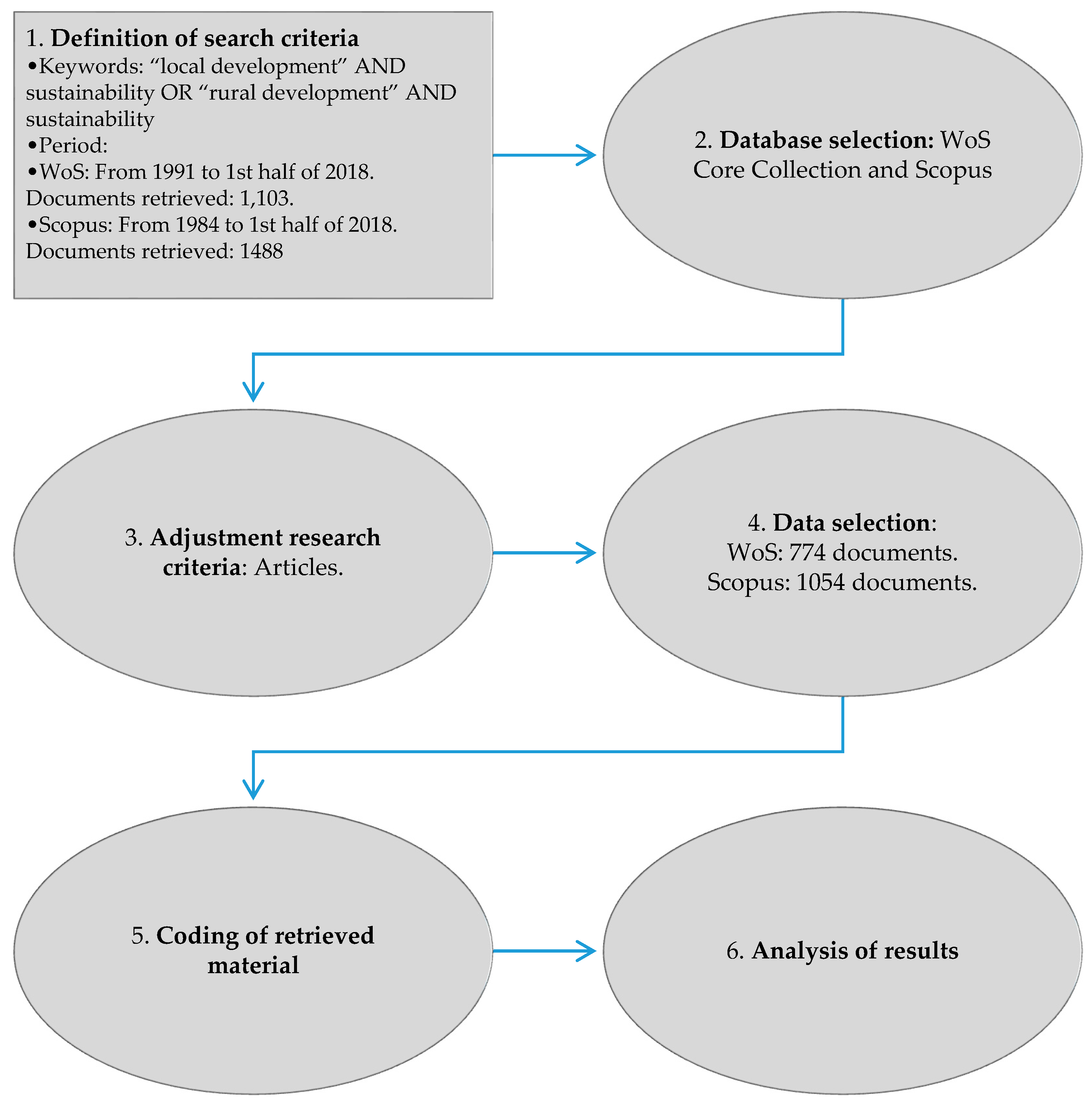
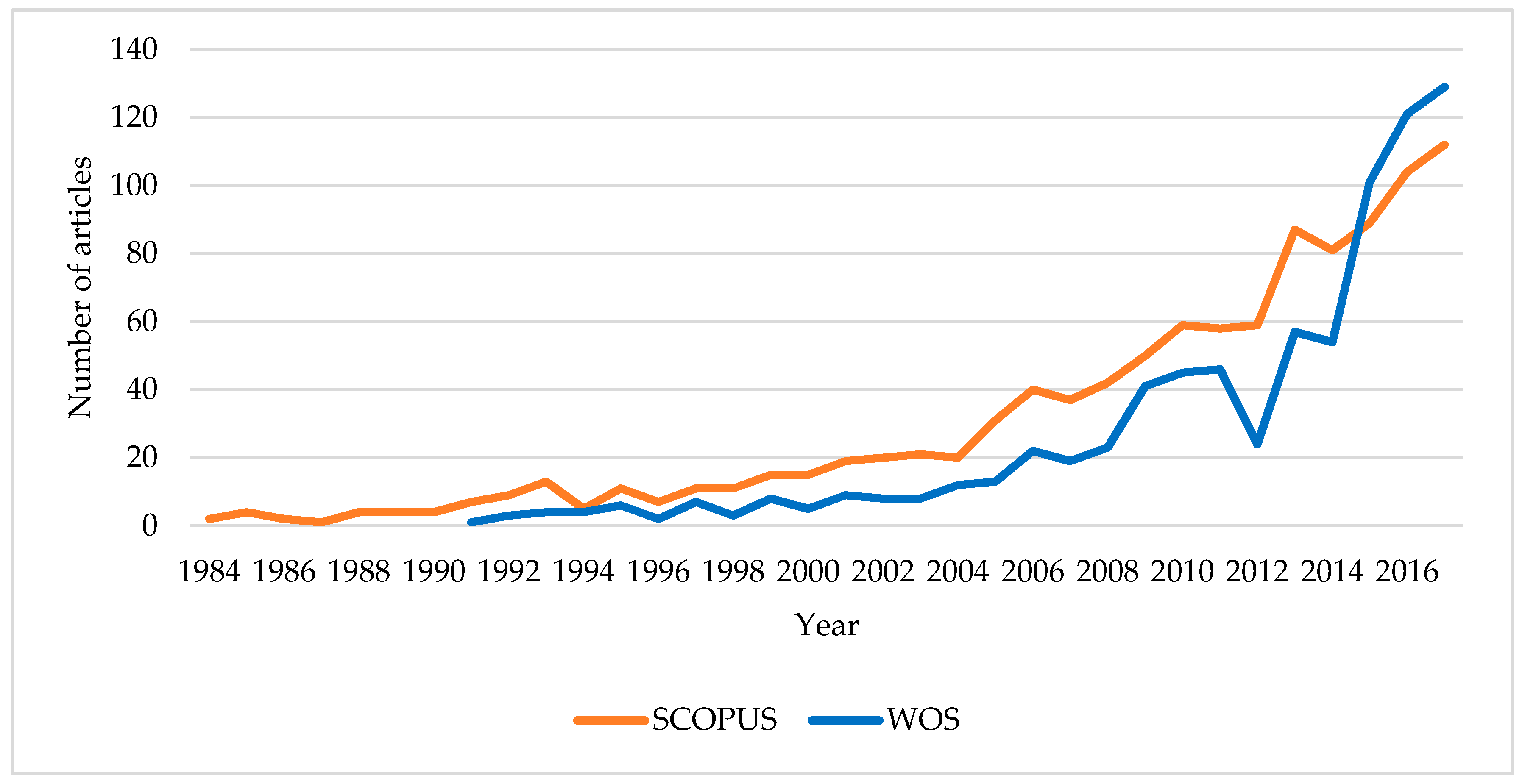
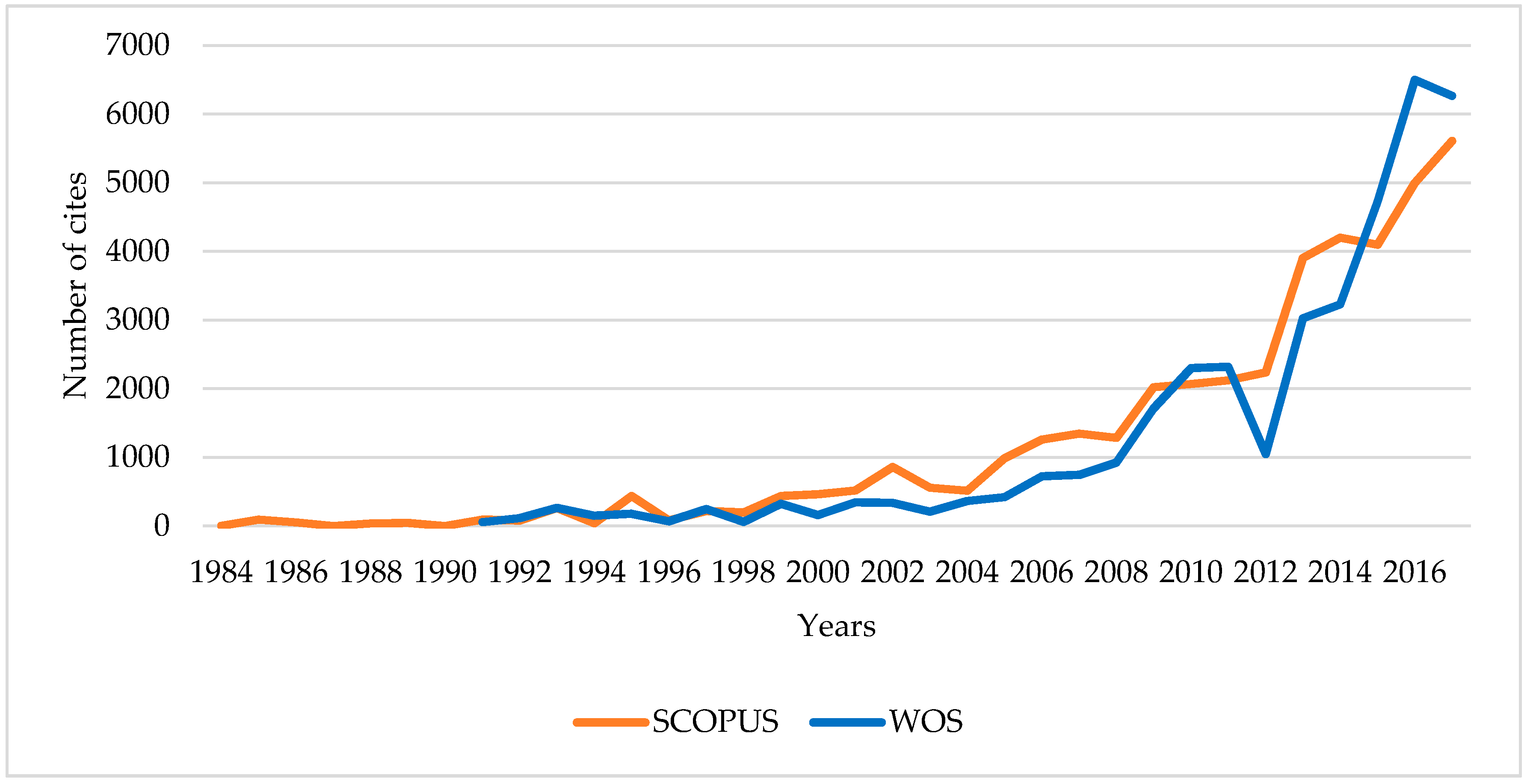
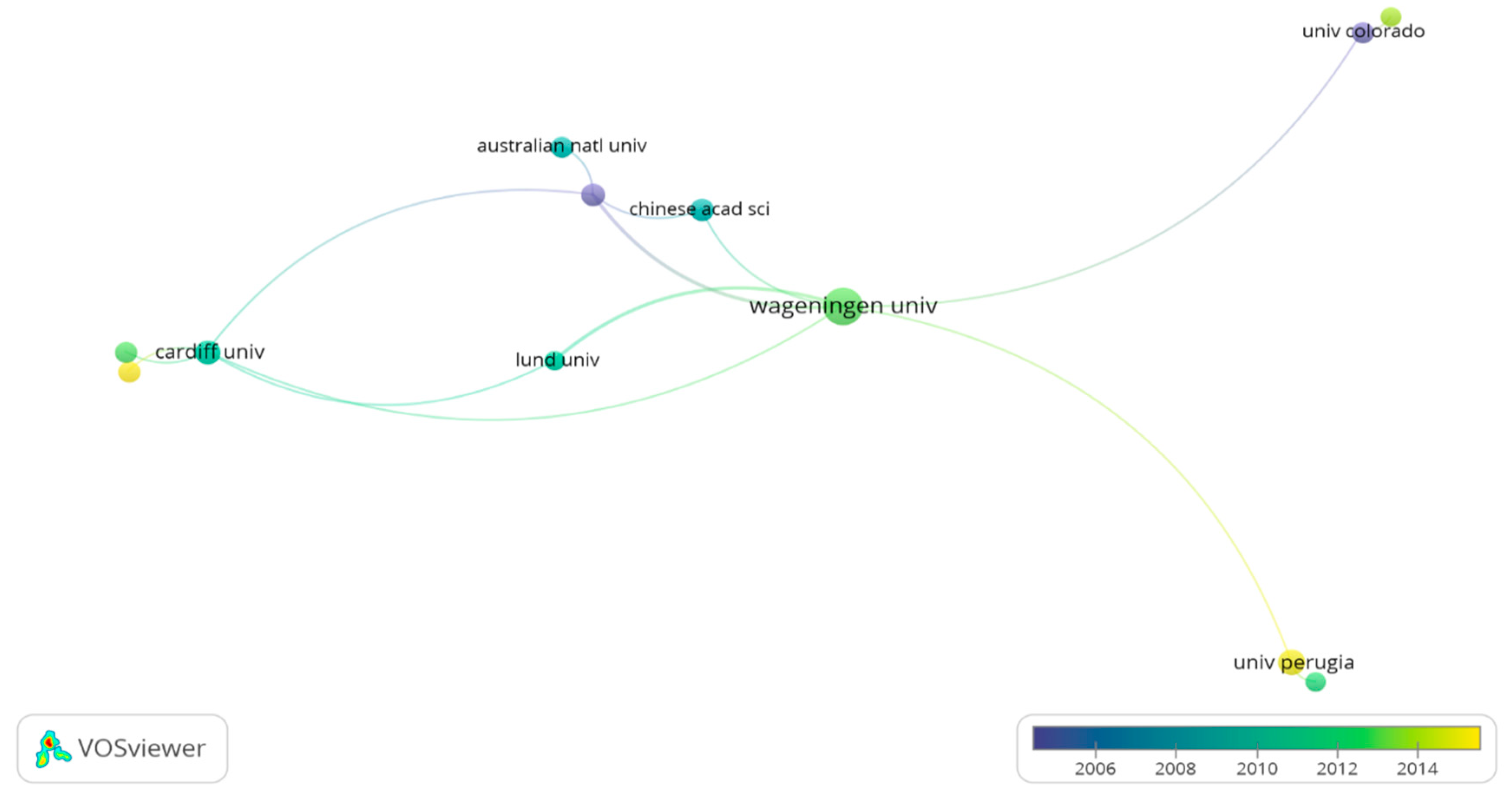
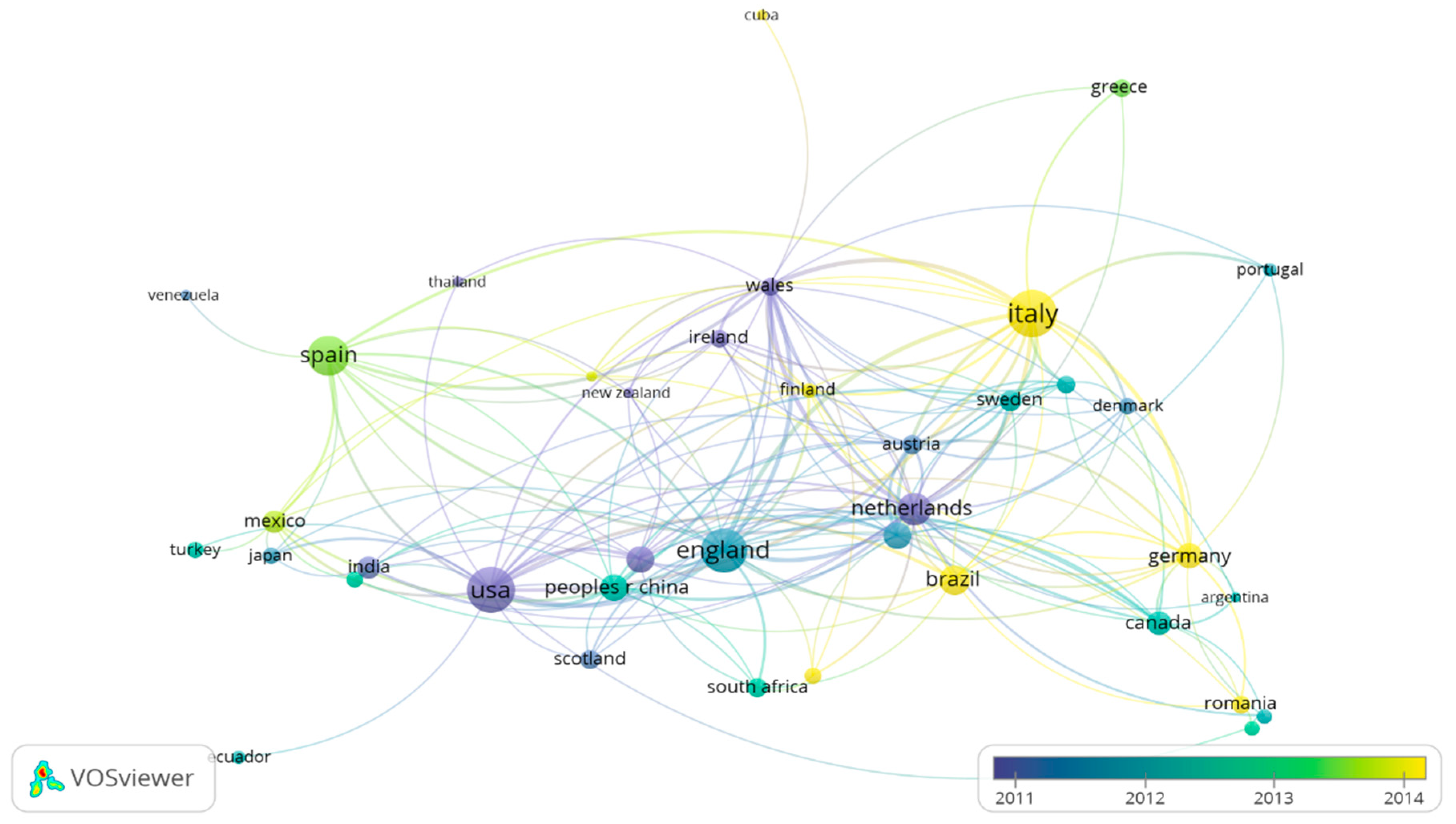
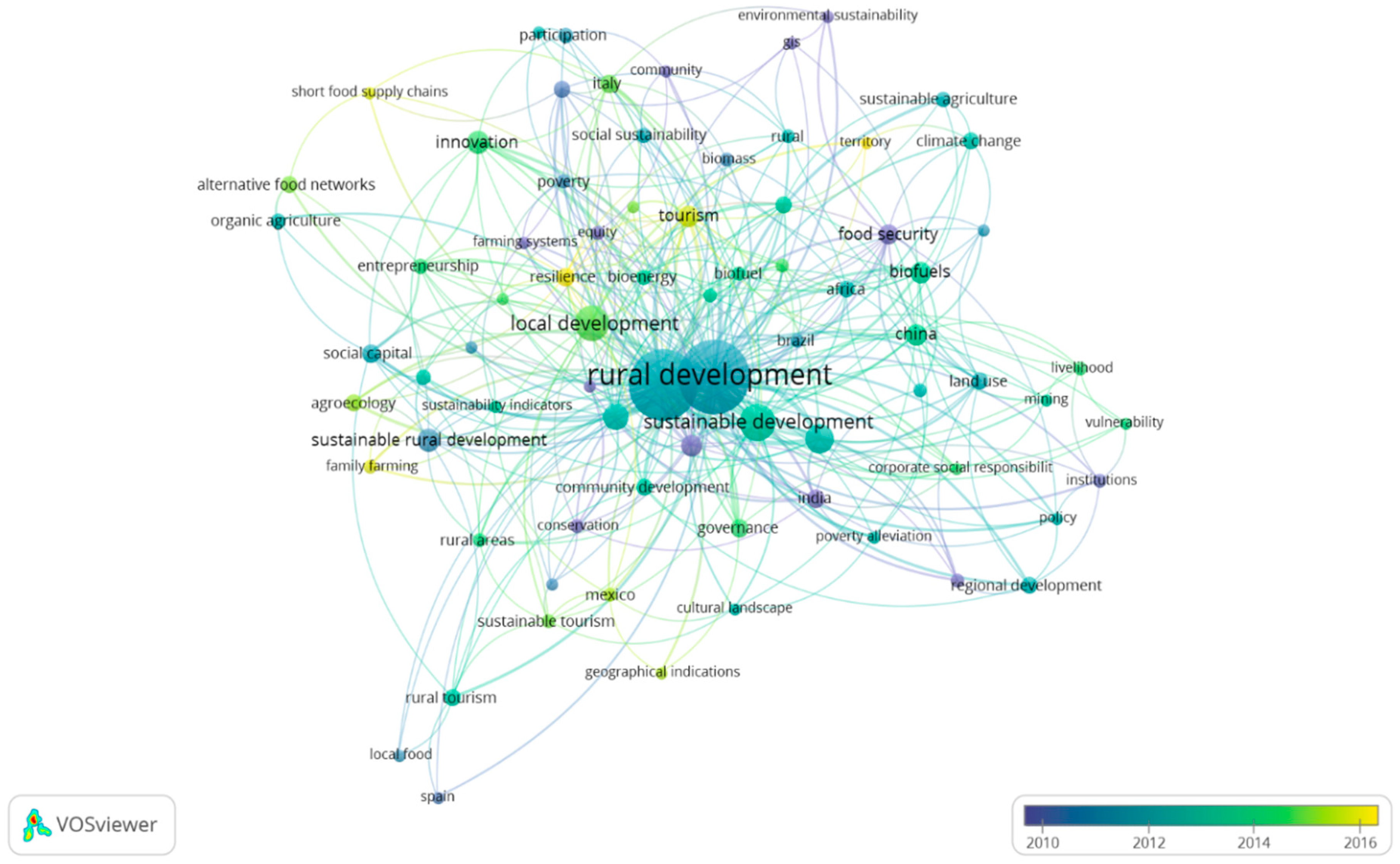
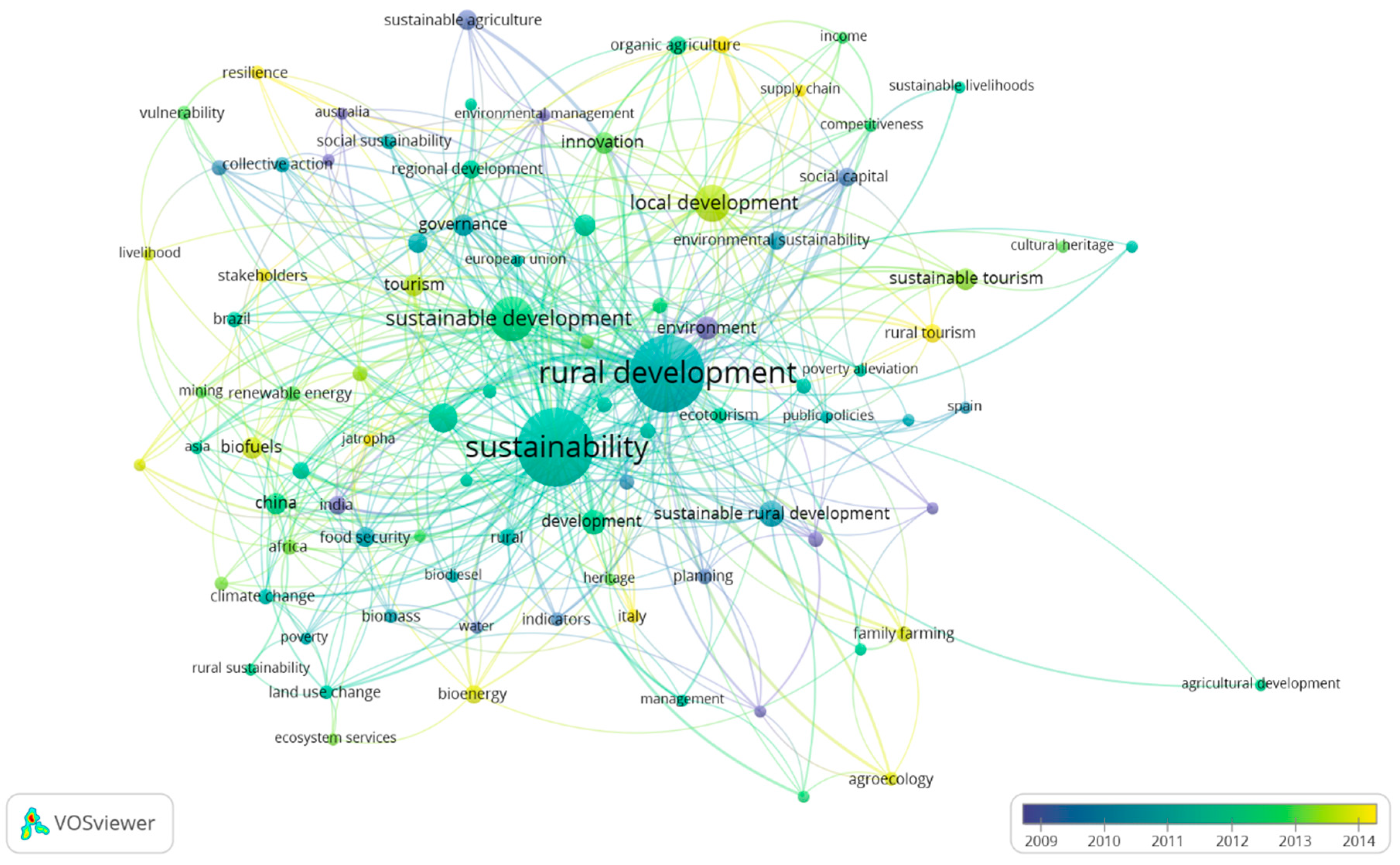
| Year | Articles (W/S) | Author (W/S) | Countries (W/S) | Journal (W/S) | NR (W/S) | TC (W/S) |
|---|---|---|---|---|---|---|
| 1984 | -/2 | -/3 | -/1 | -/2 | -/2 | -/0 |
| 1985 | -/4 | -/10 | -/2 | -/3 | -/92 | -/0 |
| 1986 | -/2 | -/4 | -/1 | -/2 | -/53 | -/0 |
| 1987 | -/1 | -/1 | -/1 | -/1 | -/0 | -/10 |
| 1988 | -/4 | -/6 | -/1 | -/4 | -/38 | -/10 |
| 1989 | -/4 | -/4 | -/1 | -/4 | -/44 | -/13 |
| 1990 | -/4 | -/13 | -/4 | -/4 | -/0 | -/15 |
| 1991 | 1/7 | 1/12 | 1/6 | 1/5 | 57/94 | 23/15 |
| 1992 | 3/9 | 5/10 | 3/2 | 3/9 | 114/76 | 18/28 |
| 1993 | 4/13 | 10/20 | 4/5 | 4/13 | 263/261 | 58/28 |
| 1994 | 4/5 | 6/7 | 4/2 | 4/5 | 149/41 | 21/34 |
| 1995 | 6/11 | 12/22 | 5/5 | 5/10 | 178/437 | 182/43 |
| 1996 | 2/7 | 4/11 | 3/5 | 2/7 | 69/80 | 36/46 |
| 1997 | 7/11 | 9/15 | 7/5 | 7/10 | 246/217 | 286/49 |
| 1998 | 3/11 | 7/20 | 2/5 | 3/10 | 60/196 | 23/59 |
| 1999 | 8/11 | 13/26 | 8/11 | 7/15 | 324/436 | 867/61 |
| 2000 | 5/15 | 12/20 | 7/11 | 5/11 | 157/462 | 138/53 |
| 2001 | 9/19 | 20/35 | 9/14 | 8/17 | 343/517 | 686/97 |
| 2002 | 8/20 | 11/39 | 7/14 | 8/20 | 336/859 | 232/91 |
| 2003 | 8/21 | 19/34 | 9/15 | 8/21 | 209/556 | 116/128 |
| 2004 | 12/20 | 17/32 | 11/17 | 12/18 | 363/514 | 298/123 |
| 2005 | 13/31 | 32/68 | 8/22 | 13/25 | 420/988 | 373/174 |
| 2006 | 22/40 | 60/99 | 17/28 | 16/32 | 722/1259 | 620/239 |
| 2007 | 19/37 | 70/80 | 18/26 | 17/34 | 744/1346 | 993/297 |
| 2008 | 23/42 | 86/95 | 23/35 | 20/37 | 924/1283 | 855/388 |
| 2009 | 41/50 | 119/160 | 39/51 | 38/75 | 1712/2022 | 793/523 |
| 2010 | 45/59 | 186/160 | 44/28 | 43/65 | 2299/2069 | 1410/667 |
| 2011 | 46/58 | 137/140 | 31/32 | 42/51 | 2318/2122 | 719/776 |
| 2012 | 24/59 | 68/159 | 20/37 | 23/55 | 1045/2237 | 393/982 |
| 2013 | 57/87 | 171/160 | 35/41 | 47/72 | 3025/3904 | 609/1207 |
| 2014 | 54/81 | 160/159 | 29/42 | 51/68 | 3227/4200 | 448/1320 |
| 2015 | 101/89 | 287/160 | 47/41 | 85/71 | 4724/4095 | 491/1513 |
| 2016 | 121/104 | 379/160 | 54/48 | 96/79 | 6497/4995 | 369/1608 |
| 2017 | 129/112 | 389/160 | 58/42 | 108/87 | 6265/5606 | 138/1918 |
| Research Areas WoS | Articles | Research Areas Scopus | Articles |
|---|---|---|---|
| Environmental sciences ecology | 256 | Social Science | 594 |
| Agriculture | 144 | Environmental Science | 409 |
| Geography | 122 | Agricultural Biological Sciences | 239 |
| Business economics | 102 | Economics, Econometrics and Finance | 121 |
| Public administration | 98 | Energy | 121 |
| Science technology | 91 | Business, Management and Accounting | 106 |
| Social sciences | 47 | Earth and Planetary Sciences | 95 |
| Sociology | 42 | Engineering | 54 |
| Energy fuels | 36 | Arts and Humanities | 38 |
| Urban studies | 30 | Medicine | 24 |
| Engineering | 28 | Computer Science | 20 |
| Forestry | 26 | Chemical Engineering | 12 |
| Physical geography | 17 | Biochemistry, Genetics and Molecular Biology | 10 |
| Institution | Country | Ranking (W/S) | Articles (W/S) | Total Cites (WS) | TC/A (WS) | H (W/S) |
|---|---|---|---|---|---|---|
| Wageningen University & Research | Netherlands | 1/1 | 31/31 | 1159/1147 | 37.38/37 | 16/18 |
| Chinese Academy of Sciences | China | -/2 | -/13 | -/266 | -/20.46 | -/8 |
| Cardiff University | UK | 2/- | 11/- | 508/- | 46.18/- | 9/- |
| Institute of Geographical Sciences and Natural Resources Research Chinese Academy of Sciences | China | -/3 | -/11 | -/240 | -/21.81 | -/8 |
| Newcastle University UK | UK | 3/5 | 11/9 | 174/120 | 15.81/13.33 | 8/5 |
| University of California | US | 4/7 | 10/8 | 596/210 | 59.6/26.25 | 8/6 |
| INRA | France | 5/4 | 10/10 | 269/753 | 26.9/75.3 | 6/7 |
| University of London | UK | 6/- | 10/- | 45/- | 4.5/- | 4/- |
| Wageningen Environmental Research Alterra | Netherlands | 7/- | 9/- | 515/- | 57.22/- | 7/- |
| Imperial College London | UK | 8/- | 9/- | 329/- | 36.56/- | 5/- |
| CIRAD | France | 9/- | 9/- | 108/- | 12/- | 4/- |
| University of Perugia | Italy | 10/- | 9/- | 51/- | 5.67/- | 4/- |
| University of Leeds | UK | -/6 | -/8 | -/292 | -/36.5 | -/7 |
| Universidade de Sao Paulo | Brazil | -/8 | -/8 | -/59 | -/7.37 | -/4 |
| Universidad del Zulia | Venezuela | -/9 | -/8 | -/9 | -/1.12 | -/2 |
| University of Colorado | U.S. | -/10 | -/7 | -/1081 | -/154.42 | -/6 |
| Source Title | Country | Ranking (W/S) | A (W/S) | JCR/SJR | TC (W/S) | TC/A (W/S) | H (W/S) |
|---|---|---|---|---|---|---|---|
| Sustainability | Switzerland | 1/1 | 25/33 | 2.075/0.537 | 121/204 | 4.84/6.18 | 6/9 |
| Journal of Rural Studies | UK | 2/2 | 20/17 | 2.658/1.113 | 555/553 | 27.75/32.53 | 11/10 |
| Land Use Policy | Netherlands | 3/3 | 20/16 | 3.194/1.348 | 318/316 | 15.9/19.75 | 10/9 |
| Quality Access To Success | Romania | -/5 | -/14 | -/0.229 | -/53 | -/3.78 | -/4 |
| Boletín de la Asociación de Geógrafos Españoles | Spain | 4/8 | 12/12 | 0.333/0.247 | 42/62 | 3.5/5.17 | 2/4 |
| Wit Transactions on Ecology and the Environment | UK | -/9 | -/12 | -/0.145 | -/4 | -/0,33 | -/1 |
| Sociologia Ruralis | UK | 5/4 | 11/14 | 2.632/0.737 | 442/375 | 40.18/26.79 | 8/10 |
| Ecological Economics | Netherlands | 6/6 | 11/12 | 3.895/1.657 | 239/338 | 21.72/28.17 | 7/7 |
| Energy Policy | UK | 7/7 | 11/12 | 4.039/1.994 | 191/274 | 17.36/22.83 | 8/8 |
| International Journal of Sustainable Development and World Ecology | UK | -/11 | -/11 | 2.373/0.687 | -/86 | -/7.81 | -/6 |
| World Development | UK | 8/10 | 10/11 | 3.166/2.122 | 1,128/1,283 | 112.8/116.64 | 9/8 |
| Agricultural Systems | UK | 9/13 | 10/9 | 3.004/1.156 | 505/544 | 50.5/60.44 | 7/7 |
| International Journal of Agricultural Sustainability | UK | 10/- | 9/- | 2.702/1.235 | 398/- | 44.22/- | 7/- |
| Journal of Cleaner Production | Netherlands | 11/- | 8/- | 5.651/1.47 | 122/- | 15.25/- | 5/- |
| Biomass & Bioenergy | UK | 12/12 | 8/10 | 3.358/1.235 | 67/125 | 8.37/12.5 | 4/6 |
| New Medit | Italy | 13/- | 8/- | 0.647/0.35 | 22/- | 2.75/- | 3/- |
| Author | Country | Ranking (W/S) | A (W/S) | TC (W/S) | TC/A (W/S) | H (W/S) | 1st | Last |
|---|---|---|---|---|---|---|---|---|
| Bebbington, A. | Australia | 1/1 | 4/8 | 894/1232 | 223.5/154 | 4/7 | 1997 | 2001 |
| Fischer, J. | Germany | 3/- | 4/- | 155/- | 38.75/- | 3/- | 2012 | 2016 |
| Giampietri, E. | Italy | 8/- | 4/- | 20/- | 5/- | 3/- | 2016 | 2017 |
| Hengsdijk, H. | Netherlands | 6/- | 4/- | 54/- | 13.5/- | 3/- | 1999 | 2008 |
| Leakey, R.R.B. | UK | 7/- | 4/- | 42/- | 10.5/- | 2/- | 1997 | 2017 |
| Marsden, T. | UK | 2/3 | 4/4 | 221/301 | 55.25/75.25 | 4/3 | 2000 | 2009 |
| Quaranta, G. | Italy | 9/6 | 4/4 | 14/13 | 3.5/3.25 | 2/2 | 2015 | 2017 |
| Salvati, L. | Italy | 5/- | 4/- | 61/- | 15.25/- | 4/- | 2011 | 2015 |
| Salvia, R. | Italy | 10/2 | 4/5 | 14/14 | 3.5/2.8 | 2/2 | 2015 | 2017 |
| Sonnino, R. | UK | 4/- | 4/- | 124/- | 31/- | 4/- | 2004 | 2013 |
| Liu, Y. | China | -/4 | -/4 | -/75 | -/18.75 | -/4 | 2009 | 2013 |
| Jeong, J.S. | Spain | -/5 | -/4 | -/35 | -/8.75 | -/3 | 2013 | 2017 |
| Altieri, M.A. | US | -/7 | -/3 | -/176 | -/58.67 | -/3 | 1986 | 1993 |
| Di Trapani, A.M. | Italy | -/8 | -/3 | -/61 | -/20.33 | -/2 | 2014 | 2016 |
| Boggia, A. | Italy | -/9 | -/3 | -/25 | -/8.33 | -/3 | 2014 | 2016 |
| Amezaga, J.M. | UK | -/10 | -/3 | -/12 | -/4 | -/3 | 2013 | 2013 |
| Country | Ranking (W/S) | Articles (W/S) | TC (W/S) | TC/A (W/S) | H (W/S) |
|---|---|---|---|---|---|
| United Kingdom | 1/1 | 121/132 | 3068/3338 | 25.35/25.28 | 28/30 |
| Italy | 2/3 | 102/106 | 1347/1384 | 13.20/13.05 | 14/17 |
| United States | 3/2 | 98/128 | 3004/2971 | 30.65/23.21 | 27/25 |
| Spain | 4/4 | 71/76 | 570/695 | 8.03/9.14 | 12/12 |
| Netherlands | 5/5 | 49/57 | 1451/1758 | 29.61/30.84 | 18/21 |
| Brazil | 6/6 | 40/50 | 190/278 | 4.75/5.56 | 8/8 |
| Australia | 7/10 | 33/39 | 525/853 | 15.91/21.87 | 13/15 |
| France | 8/8 | 32/41 | 1068/1026 | 33.38/25.02 | 12/11 |
| Germany | 9/7 | 31/43 | 699/813 | 22.55/18.91 | 12/14 |
| China | 10/9 | 31/41 | 631/486 | 20.35/11.85 | 12/12 |
© 2019 by the authors. Licensee MDPI, Basel, Switzerland. This article is an open access article distributed under the terms and conditions of the Creative Commons Attribution (CC BY) license (http://creativecommons.org/licenses/by/4.0/).
Share and Cite
Milán-García, J.; Uribe-Toril, J.; Ruiz-Real, J.L.; de Pablo Valenciano, J. Sustainable Local Development: An Overview of the State of Knowledge. Resources 2019, 8, 31. https://doi.org/10.3390/resources8010031
Milán-García J, Uribe-Toril J, Ruiz-Real JL, de Pablo Valenciano J. Sustainable Local Development: An Overview of the State of Knowledge. Resources. 2019; 8(1):31. https://doi.org/10.3390/resources8010031
Chicago/Turabian StyleMilán-García, Juan, Juan Uribe-Toril, José Luis Ruiz-Real, and Jaime de Pablo Valenciano. 2019. "Sustainable Local Development: An Overview of the State of Knowledge" Resources 8, no. 1: 31. https://doi.org/10.3390/resources8010031
APA StyleMilán-García, J., Uribe-Toril, J., Ruiz-Real, J. L., & de Pablo Valenciano, J. (2019). Sustainable Local Development: An Overview of the State of Knowledge. Resources, 8(1), 31. https://doi.org/10.3390/resources8010031








